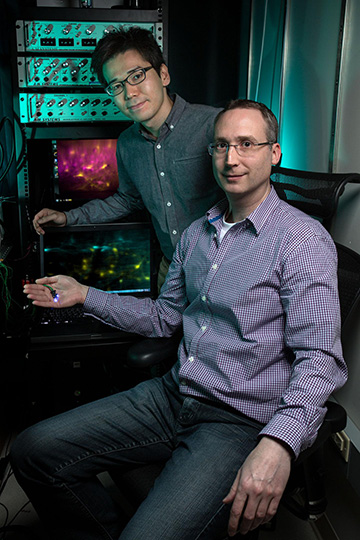
Salk researchers Kohei Sekiguchi and Axel Nimmerjahn report imaging data on spinal cellular activity during behavior, enabled by their innovative miniaturized microscopes. Credit: The Salk Institute
It is difficult to obtain stable images of spinal cord cells because, unlike cells in the brain, these cells are surrounded by things that move—an articulated spine, a beating heart, and expanding lungs. Researchers from The Salk Institute (USA) report they have overcome this challenge by using new fluorescence imaging approaches based on miniaturized one-photon and two-photon microscopy to image cellular activity in the spinal cords of freely behaving mice (Nat. Commun., doi: 10.1038/ncomms11450).
The authors say that the imaging techniques may someday improve researchers’ understand nervous system function, allowing them to create better therapies for spinal cord injuries and neurodegenerative diseases like amyotrophic lateral sclerosis (ALS).
Miniaturized one-photon and two-photon microscopy
Previous electrophysiological techniques were used to view electrically excitable cell activity in the brain and spinal cord, but they could not record chemically excitable cells. Current optical imaging and florescent labelling methods allow researchers to view both types of cells, but only in stable structures, like the brain. Led by Axel Nimmerjahn, the Salk team improved existing optical imaging and fluorescent-labelling methods to create miniaturized one-photon and two-photon microscopes that would image spinal cord cells in freely behaving mice.
The researchers attached custom-made miniaturized one-photon microscopes to the backs of awake and moving mice. With this method, they were able to capture images with a resolution of 1,280 x 960 pixels, with 80 to 100 recordings taken per one- to two-minute session. For imaging awake but restrained mice, they used an upright two-photon microscope with an adaptive focus control unit to allow for real-time measurement and correction of axial distance changes between the microscope lens and the mouse’s spinal cord window. The image resolution for this method was 256 x 512 pixels at a frame rate of 61.8 per second, or 512 x 512 pixels at a frame rate of 30.9 per second.
Correcting motion artifacts
For both microscopy methods, lateral motion artifacts were corrected using TurboReg—an automated algorithm that aligns images using a cellular structure “landmark.” To estimate axial tissue movement, a reference z-stack was created from spinal cord images at different focal positions for each anesthetized mouse (40 images taken at 1 µm axial spacing). Cellular landmarks in the z-stack were compared to landmarks in the time-lapse images collected during one- and two-photon microscopy.
Using these new imaging methods, the scientists say they observed distinct cutaneous stimuli activating overlapping ensembles of electrically excitable dorsal horn nerve cells, and that stimulus type and intensity is encoded at the single-cell level. Conversely, the team also reports observing astrocytes—chemically activated spinal cord cells—generating large-scale coordinated chemical signals when they experience intense sensory inputs.
